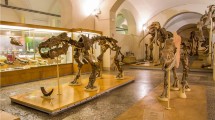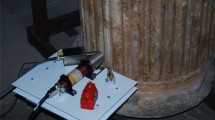Abstract
Natural heritage is an important part of cultural heritage. More specifically, the protection and preservation of the unique biodiversity of flora and fauna in a specific region is an important part of preserving and celebrating the cultural diversity and identity of a region and of a nation. Nottingham is a home of pre-historic natural heritage and specifically of the ‘Nottingham Ichthyosaur’; a new species Protoichthyosaurus applebyi named in 2017 which was discovered in the area, probably in the early part of the 19th century. The near-complete type specimen of the species is on display at the Life Sciences building of the University of Nottingham. In this work, we describe the process which was used to digitally preserve the specimen which, it is hoped, will be lodged in an appropriate museum. The purpose of the digital preservation would be to aid teaching and research purposes as well as exploit the data for further distributed research by other natural scientists. To digitise the fossil, which was embedded, in cement a commercial fringe projection system was used to register the bone structure and grayscale imaging was used to register the texture of the bones on display.
Access this chapter
Tax calculation will be finalised at checkout
Purchases are for personal use only
Similar content being viewed by others
References
Lerma, J.L., Navarro, S., Cabrelles, M., Villaverde, V.: Terrestrial laser scanning and close range photogrammetry for 3D archaeological documentation: the Upper Palaeolithic Cave of Parpalló as a case study. J. Archaeol. Sci. 37, 499–507 (2010)
Pavlidis, G., Tsiafakis, D., Koutsoudis, A., Arnaoutoglou, F., Tsioukas, V., Chamzas, C.: Preservation of architectural heritage through 3D digitization. Int. J. Archit. Comput. 5, 221–237 (2007)
Hermon, S., Polig, M., Driessen, J., Jans, G., Bretschneider, J.: An integrated 3D shape analysis and scientific visualization approach to the study of a Late Bronze Age unique stone object from Pyla-Kokkinokremos. Cyprus. Digit. Appl. Archaeol. Cult. Herit. 10, e00075 (2018)
Themistocleous, K., Ioannides, M., Agapiou, A., Hadjimitsis, D.G.: The methodology of documenting cultural heritage sites using photogrammetry, UAV, and 3D printing techniques: the case study of Asinou Church in Cyprus. In: Proceedings of SPIE - The International Society for Optical Engineering, vol. 9535, p. 953510 (2015)
Frankowski, G., Hainich, R.: DLP-based 3D metrology by structured light or projected fringe technology for life sciences and industrial metrology. In: Hornbeck, L.J., Douglass, M.R. (eds.) Proceedings of SPIE - The International Society for Optical Engineering, vol. 7210, p. 72100C (2009)
Agapiou, A., Hadjimitsis, D., Alexakis, D., Themistokleous, K., Cuca, B.: Integrated method for tracking changes in archeolandscapes using remote and close-range technologies: monitoring of change and risk assessment methodologies. In: 2013 Digital Heritage International Congress (DigitalHeritage), pp. 231–234. IEEE (2013)
Lomax, D.R., Massare, J.A., Mistry, R.T.: The taxonomic utility of forefin morphology in lower Jurassic Ichthyosaurs: Protoichthyosaurus and Ichthyosaurus. J. Vertebr. Paleontol. 37, e1361433 (2017)
Olsen, M.J., Johnstone, E., Kuester, F., Driscoll, N., Ashford, S.A.: New automated point-cloud alignment for ground-based light detection and ranging data of long coastal sections. J. Surv. Eng. 137, 14–25 (2011)
Cloud Compare homepage. http://www.danielgm.net/cc/. Accessed 28 June 2018
Falkingham, P.L.: Acquisition of high resolution three-dimensional models using free, open-source, photogrammetric software. Palaeontol. Electron. 15, 1–15 (2012)
Author information
Authors and Affiliations
Corresponding author
Editor information
Editors and Affiliations
Rights and permissions
Copyright information
© 2018 Springer Nature Switzerland AG
About this paper
Cite this paper
Stavroulakis, P., Bis-Kong, Y., Doyen, E., Hartman, T., Leach, R. (2018). Digital Preservation of the Nottingham Ichthyosaur Using Fringe Projection. In: Ioannides, M., et al. Digital Heritage. Progress in Cultural Heritage: Documentation, Preservation, and Protection. EuroMed 2018. Lecture Notes in Computer Science(), vol 11197. Springer, Cham. https://doi.org/10.1007/978-3-030-01765-1_5
Download citation
DOI: https://doi.org/10.1007/978-3-030-01765-1_5
Published:
Publisher Name: Springer, Cham
Print ISBN: 978-3-030-01764-4
Online ISBN: 978-3-030-01765-1
eBook Packages: Computer ScienceComputer Science (R0)




